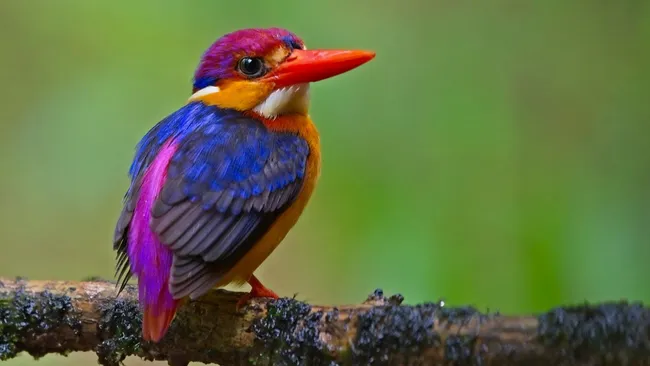Nature has crafted some truly extravagant costumes, and birds boast more than their fair share of dazzling attire. It’s often the male birds that take center stage with their bold colors and elaborate plumage, essential for captivating choosy females. However, there are instances where both males and females don eye-catching ensembles.
While you’re likely familiar with the majestic peacock, with its ornate eyespots, there’s a myriad of other avian species flaunting equally extravagant displays. Take, for instance, Wilson’s bird of paradise, showcasing an iridescent-green cape during courtship, or the resplendent quetzal, captivating potential mates with its trailing metallic-blue feathers.
Without further ado, let’s explore 32 of the world’s most vibrant birds.
Keel-billed toucan
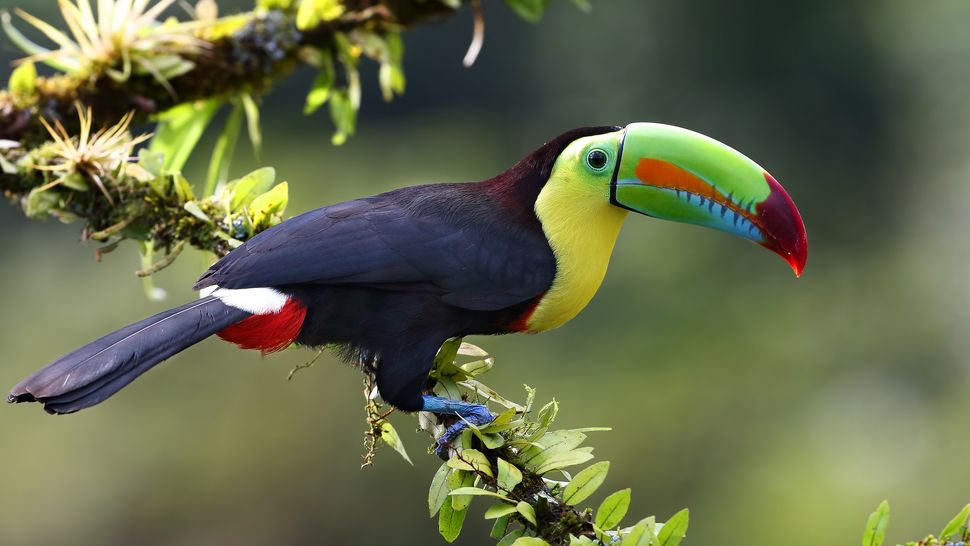
The keel-billed toucan (Ramphastos sulfuratus), also referred to as the rainbow-billed toucan, inhabits tropical regions from southern Mexico to northern Colombia and northwestern Venezuela. While its plumage primarily consists of black feathers, it features a yellow throat and cheeks, light-green eye patches, and striking red feathers beneath its tail. However, the most remarkable feature of the keel-billed toucan is undoubtedly its multicolored bill, comprising about one-third of its 20-inch (51 centimeters) length.
Despite its size, the bill is surprisingly lightweight as it is hollow, as noted by the American Bird Conservancy. Keel-billed toucans employ this distinctive appendage to forage for food, which includes a varied diet of fruit, insects, lizards, tree frogs, and eggs. They skillfully toss their prey into the air before swallowing it whole. Moreover, the vibrant hues of the bill, spanning from green and orange to blue and red, serve to attract potential mates. Research indicates that the bill is richly supplied with fine blood vessels, enabling keel-billed toucans to regulate their body temperature effectively.
Splendid fairy wren
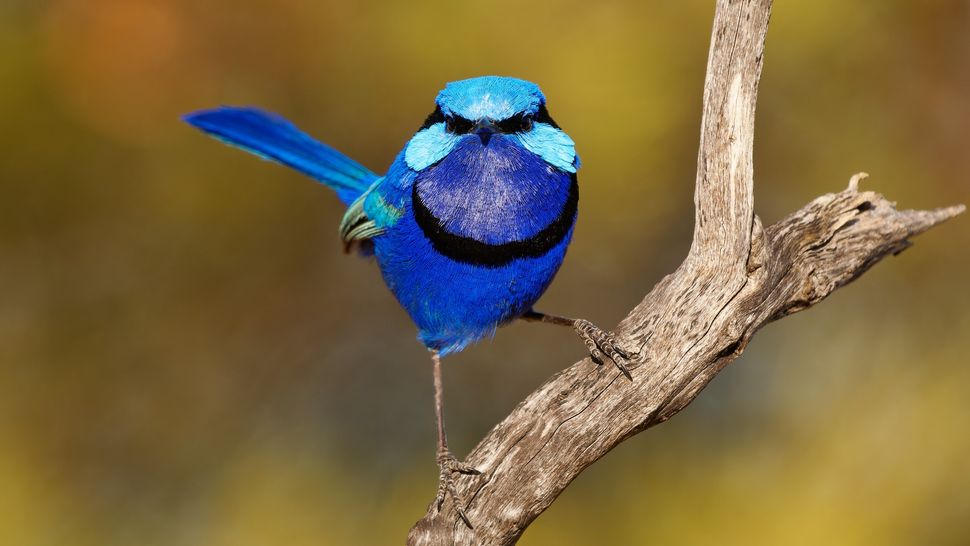
During the breeding season, the splendid fairy-wren (Malurus splendens) lives up to its name by transforming into a vision of brilliance. Males undergo a striking change, adorned with magnificent cobalt-blue feathers, accompanied by a sky-blue crown and cheeks, all aimed at captivating potential mates. These enchanting birds, measuring up to 5 inches (13 cm) in length, inhabit dense shrublands and acacia woodlands across various regions of Australia.
Like their fairy-wren counterparts, splendid fairy-wrens primarily subsist on insects, which they skillfully glean from the ground and shrubs. Come September, the males undergo a remarkable metamorphosis, shedding their pale-brown and buff plumage in favor of vibrant, electric-blue hues, accentuated by a distinctive black eye mask. It is during this time that they commence their elaborate courtship displays, which often involve the ritualistic plucking of pink and purple petals to woo potential mates.
Meanwhile, the females diligently construct their nests, fashioning them from dry grass, scraps of bark, and rootlets. These nests, characterized by their diminutive size, compel the birds to bend their tails during incubation, showcasing the resourcefulness and adaptability of these captivating creatures.
Gouldian finch
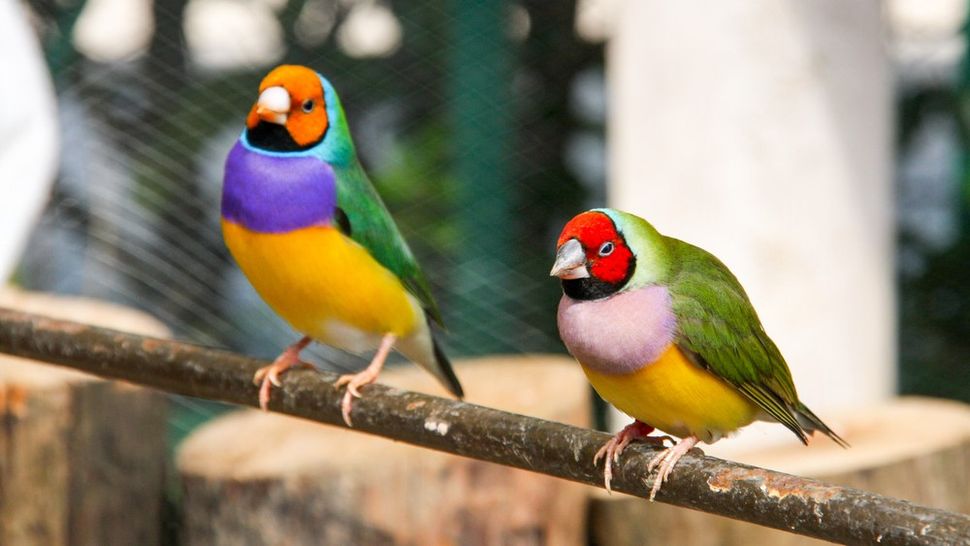
Also known as the rainbow finch, the Gouldian finch (Chloebia gouldiae) is a captivating species of grassfinch distinguished by its vibrant plumage. These finches exhibit three distinct color variations, featuring a black, red, or yellow face to complement their striking appearance. Their bright-green back, turquoise neck, yellow belly, and purple breast further contribute to their kaleidoscopic allure. Among Gouldian finches, individuals with a black facial coloration are the most prevalent, constituting approximately 75% of the population, while red-faced birds comprise the majority of the remaining 25%, with yellow-faced variants being a rare occurrence.
Inhabiting the edges of mangrove forests, thickets, and savannas in northern Australia, Gouldian finches primarily feed on grass seeds and insects. These sociable birds are often found congregating around water sources, forming flocks that can number several hundred individuals, as they have a need to drink multiple times throughout the day.
Unfortunately, the stunning colors of Gouldian finches have made them a target for illegal trapping. Alongside habitat loss, predation, parasites, and wildfires, the illicit bird trade has posed a significant threat to the species, leading to a drastic decline in the wild population, which now numbers fewer than 2,500 individuals. This decline underscores the urgent need for conservation efforts to safeguard these magnificent birds and their fragile habitats.
Fiery-throated hummingbird
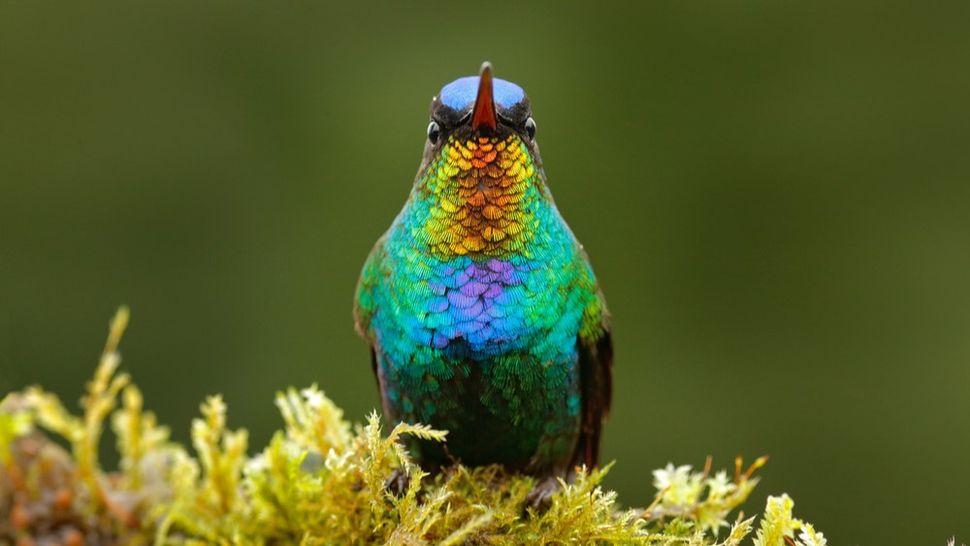
The fiery-throated hummingbird (Panterpe insignis) is a dazzling species of hummingbird native to the forested highlands of Costa Rica and western Panama. Measuring approximately 4 inches (10 cm) in length, its petite body is adorned with a mesmerizing array of iridescent feathers. These feathers transition seamlessly from a deep, fiery orange hue at the base of the throat to vibrant shades of yellow and bluish-green along the belly and back. The crowning glory of this exquisite bird is its shimmering royal blue breast and crown, adding a touch of regal elegance to its appearance.
Despite slight variations in size between males and females, both sexes boast a similar appearance, characterized by a slender physique and a long, sleek black bill with a delicate pink base. This distinctive bill serves as a specialized tool for extracting nectar from the delicate blooms of small flowers, shrubs, and trees, making the fiery-throated hummingbird a vital pollinator within its forest habitat.
Indian peafowl
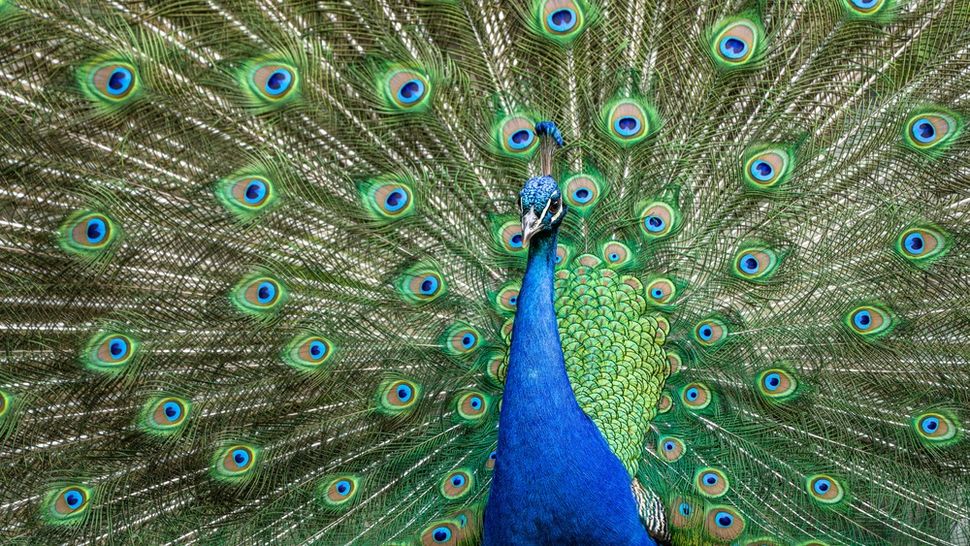
Male Indian peafowl (Pavo cristatus), commonly known as peacocks, are celebrated for their resplendent iridescent-blue plumage and magnificent eyespot-covered tails, which they unfurl in dazzling displays to court females. In contrast, females exhibit a more subdued appearance, adorned in mottled-brown plumage with a shorter tail devoid of eyespots, though they feature iridescent-green feathers on their throats.
Native to the Indian subcontinent, Indian peafowl have been introduced to numerous regions worldwide, including North America, Europe, South Africa, and Australia, primarily as ornamental birds. In their natural habitat, these majestic birds inhabit forested areas, where they scavenge for sustenance on the forest floor. Their diet consists of a variety of fare, including fruits, small reptiles, insects, and rodents, showcasing their adaptability and diverse foraging habits in the wild.
Lilac-breasted roller
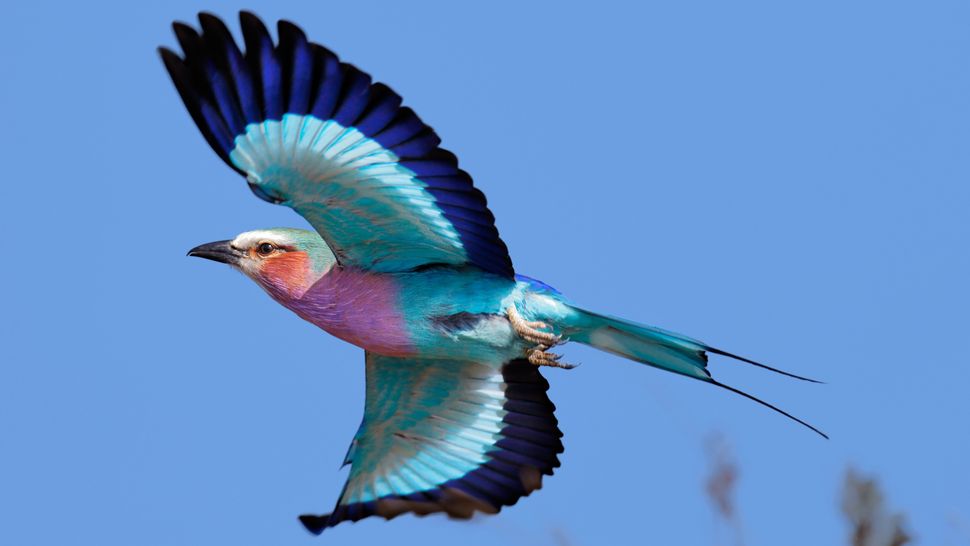
The lilac-breasted roller (Coracias caudatus) earns its name from its captivating courtship ritual, characterized by acrobatic displays where males soar, rise, and plunge with wings tucked in, executing graceful rolls accompanied by raucous calls. These rollers stand tall at around 14.5 inches (37 cm), with both males and females adorned in resplendent plumage.
Their features include a lilac throat and breast, complemented by a turquoise belly, a verdant green head, a fiery reddish-orange face, and striking royal-blue tail tips. These vibrant hues create a striking contrast against their surroundings.
Found in grasslands and wooded areas across eastern and southern Africa, from Ethiopia and Angola to northern South Africa, lilac-breasted rollers exhibit keen hunting skills. They perch atop dead trees, utilizing their elevated vantage point to scan for prey. Their diet consists of a diverse array of creatures, including grasshoppers, beetles, lizards, frogs, and even crabs. These adept hunters are known for seizing opportunities, preying on animals fleeing from bushfires and invading the nests of other avian species, such as kingfishers and woodpeckers. Such behaviors highlight the lilac-breasted roller’s adaptability and resourcefulness in its natural habitat.
Wilson’s bird of paradise
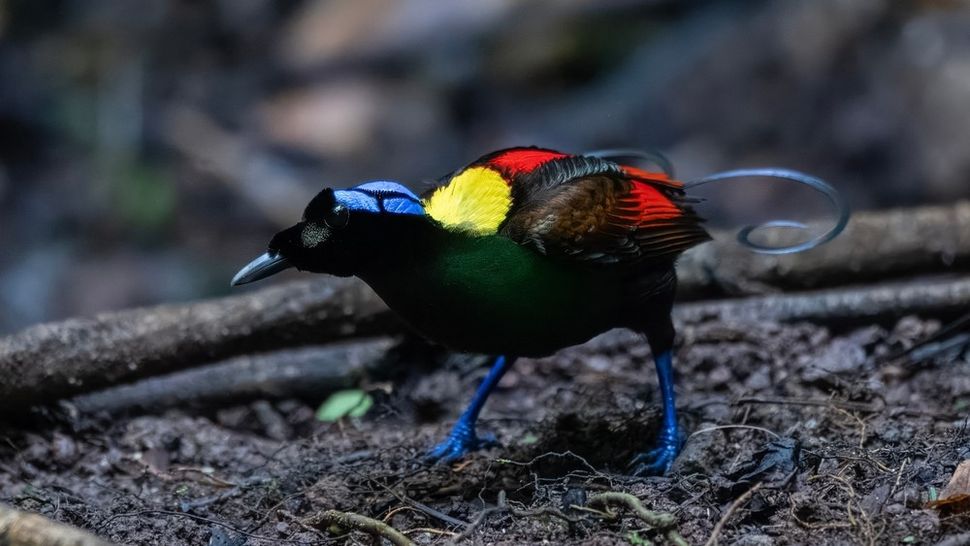
Wilson’s bird of paradise (Diphyllodes respublica) pays homage to British ornithologist Edward Wilson, who in 1850 donated a specimen discovered in Indonesia to the Academy of Natural Sciences in Philadelphia. The male of this species, roughly the size of a sparrow, is a mesmerizing sight, adorned with vivid red plumage adorning its back, a striking yellow patch atop its neck, and a distinctive featherless crown, revealing electric-blue skin underneath. Notably, Wilson’s bird of paradise sports two remarkable sickle-shaped tail feathers, adding to its allure.
This avian gem remains elusive, with its secretive nature puzzling scientists for over a century. It wasn’t until 150 years later that researchers documented its enchanting courtship display. During this ritual, the male unveils his neck feathers, unfurling an iridescent-green cape in a captivating dance. Females discern potential mates based on the brilliance of their plumage, although they themselves exhibit more subdued olive-brown, mottled plumage. Similarly, females also possess a bald patch atop their heads and boast the same striking blue skin as their male counterparts.
Red-necked tanager
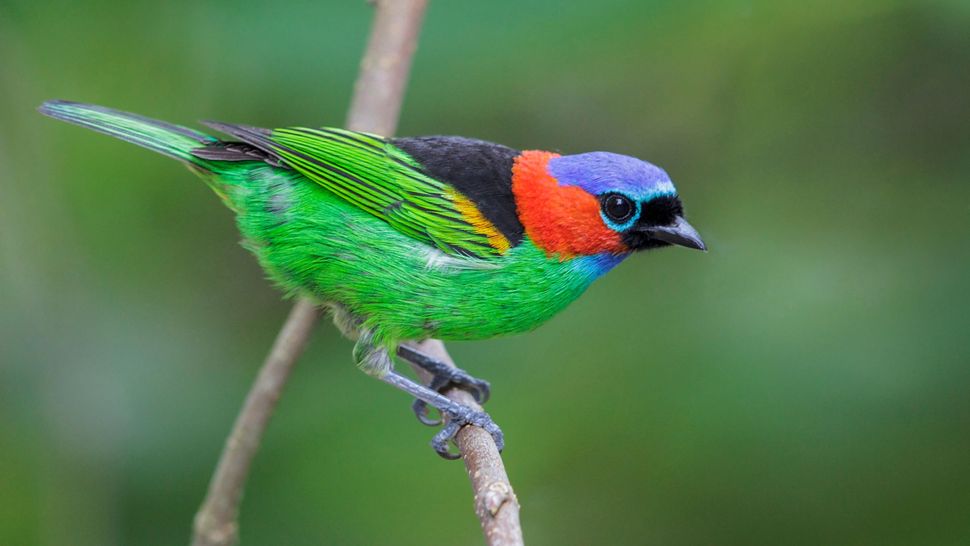
The red-necked tanager (Tangara cyanocephala) is a stunning tropical bird inhabiting the lush lowland forests of eastern Brazil, Argentina, and Paraguay. Adorned predominantly in light green plumage, it boasts striking features including a scarlet nape and cheeks, a delicate light-purple crown, and a captivating blue throat.
These vibrant tanagers typically forage at the canopy level of fruiting trees, where they indulge in a varied diet consisting primarily of fruits. However, they occasionally descend to the forest floor to feast on berries plucked from shrubs below. With a lifespan of up to five years, red-necked tanagers contribute to the rich tapestry of life within their tropical habitats, adding a splash of color and vitality to the verdant landscape.
Resplendent quetzal
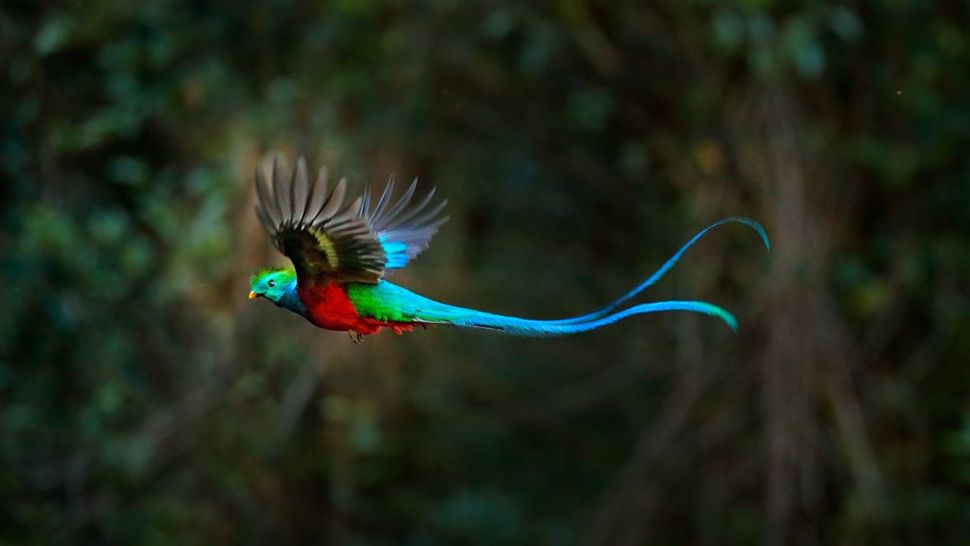
The resplendent quetzal (Pharomachrus mocinno) is an awe-inspiring avian beauty, adorned in hues of turquoise, green, and red, gracing the cloud forests that stretch from southern Mexico to western Panama. Among its striking features, males boast a regal golden-green crest and magnificent metallic-blue tail feathers that undergo remarkable growth during the breeding season, forming a flowing train measuring up to 3 feet (0.9 meters) in length. With these resplendent adornments, they engage in captivating courtship displays, soaring above the forest canopy before plunging down toward potential mates, their vibrant feathers rippling gracefully behind them.
The resplendent quetzal holds deep cultural significance, revered as sacred by Mesoamerican civilizations and retaining its importance as a symbol to this day, notably featured on Guatemala’s national flag. Legend intertwines with its majestic presence, as it is said to have served as the spirit guide of Tecún Umán, a legendary Maya prince and hero who valiantly fought against the Spanish conquest. According to folklore, as Tecún Umán lay wounded on the battlefield, a resplendent quetzal alighted upon his chest, its feathers stained with his blood, thus accounting for the bird’s vivid red breast and belly—a poignant testament to its enduring mythos and cultural resonance.
Spangled cotinga
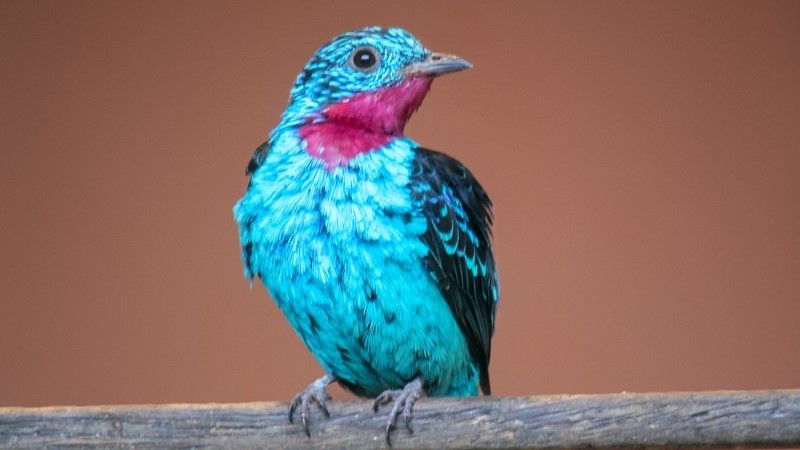
The spangled cotinga (Cotinga cayana) is a captivating tropical bird found within the verdant forests and jungles of northern South America, including the vast expanse of the Amazon rainforest in Brazil. Distinguished by its vibrant plumage, males showcase an enchanting display of light-blue feathers adorning their breast and belly, complemented by bluish-black wings and a resplendent magenta throat. These striking attributes serve as alluring ornaments to attract potential mates, contrasting with the much more subdued brown plumage of the females.
Measuring between 7 and 9 inches (18 to 23 cm) in length, spangled cotingas are often observed perched atop fruiting trees, where they indulge in a varied diet comprising fruits and protein-rich insects, particularly during the breeding season. Their presence adds a splash of color and vitality to the lush canopy of the rainforest, embodying the rich biodiversity of their tropical habitat.
Mandarin duck
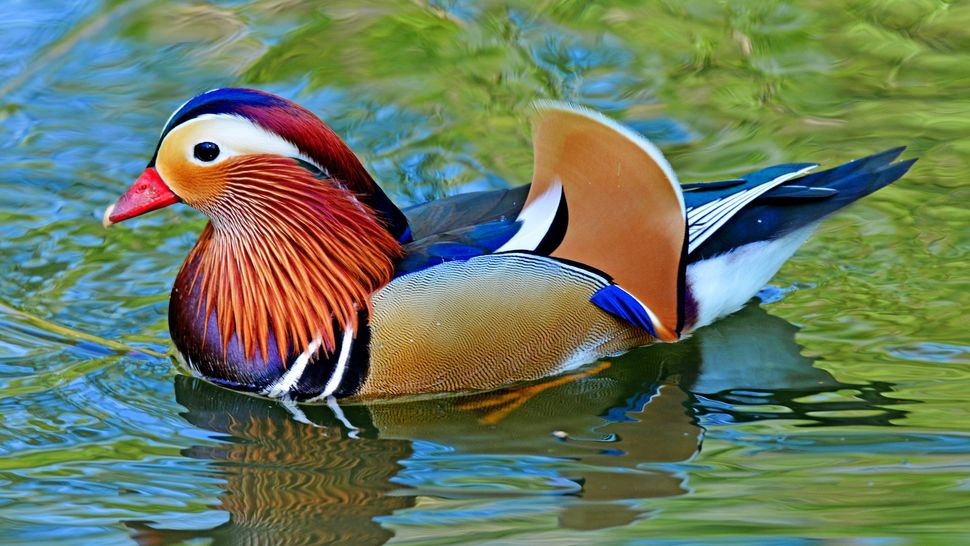
The male mandarin duck (Aix galericulata) is renowned for its striking and vibrant colors, standing out among its avian counterparts. These males boast distinctive orange cheeks and ornate “sails” adorning their backs, alongside a regal purple chest and resplendent royal-blue and green feathers gracing their crown and tail. In contrast, females exhibit a more subdued appearance, characterized by creamy-white and mottled-brown plumage, with a gray head and cheek feathers that resemble those of the males when fluffed up. Adults of both sexes typically measure between 8 and 10 inches (20 to 25 cm) in length, with females tending to be slightly plumper than males.
Native to the Far East, including regions of China, Japan, Korea, and parts of Russia, mandarin ducks have also found their way to other parts of the world. Introduced to the U.K. during the 20th century, they have established populations in various regions. Additionally, sightings of mandarin ducks have been reported in parts of the United States, believed to be the result of escaped captive individuals. These elegant ducks bring a touch of exotic beauty wherever they roam, captivating observers with their dazzling plumage and graceful demeanor.
Crimson rosella
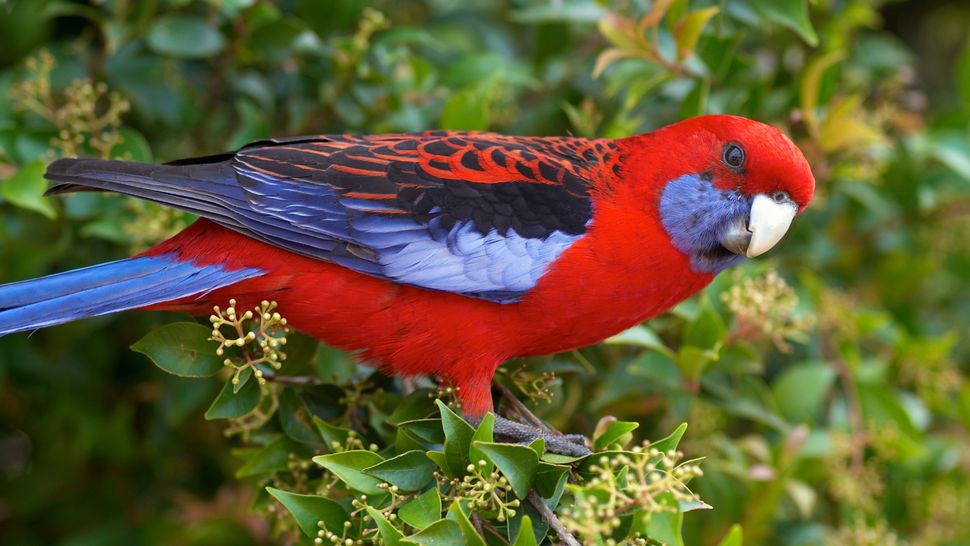
Despite its name, the crimson rosella (Platycercus elegans) showcases a spectrum of hues, encompassing shades of red, orange, and yellow. Juveniles initially don olive-green plumage, which gradually transitions to one of these vibrant colors as the birds mature. Regardless of their coloration, crimson rosellas are characterized by distinctive blue patches adorning their cheeks, along with blue tail feathers and wings adorned with conspicuous black dots.
These charming avians predominantly inhabit southern and eastern Australia, with scattered populations across the rest of the country, as well as on Norfolk Island and in New Zealand. Typically congregating in small flocks, crimson rosellas sustain themselves by foraging on a varied diet of seeds, grasses, shrubs, insects, and occasional tree blossoms. Their vocal repertoire encompasses a diverse range of calls, ranging from harsh screeches to melodic metallic whistles, adding to the auditory tapestry of their natural habitat.
Common kingfisher
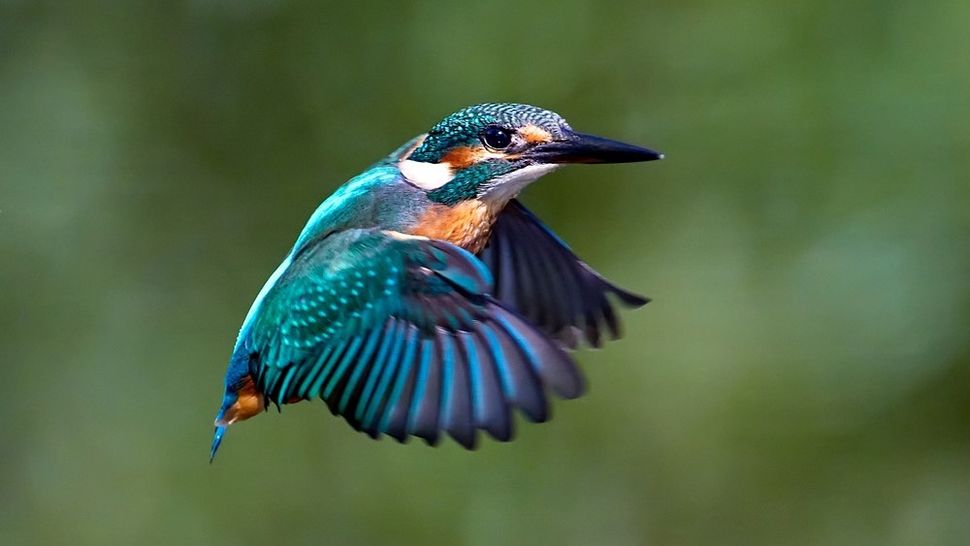
The common kingfisher (Alcedo atthis) stands out with its vibrant blue and orange plumage, a striking sight across the diverse landscapes of Europe, Asia, and North Africa. Despite its colorful appearance, it tends to be a rather shy and unobtrusive bird, often found perched in trees along the banks of rivers and streams.
Equipped with a long, pointed bill, the common kingfisher skillfully employs its specialized tool to pluck small fish from slow-moving or still waters. It executes its hunting technique with precision, diving low above the surface when it spots a potential meal.
Measuring approximately 6 inches (15 cm) in length, with a wingspan of around 10 inches (25 cm), the common kingfisher possesses a compact yet agile physique, slightly larger than that of a European robin. Its metallic blue back and coppery-brown breast create a striking contrast, adding to its allure.
One notable feature distinguishing females from males is the presence of a red patch at the base of the bill—a subtle yet distinctive characteristic in these remarkable birds.
Red-bearded bee-eater
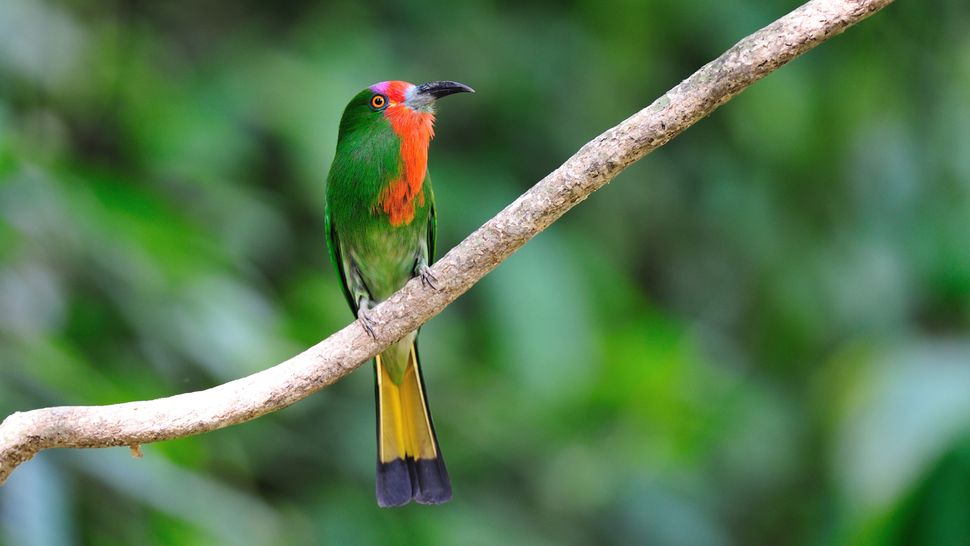
The red-bearded bee-eater (Nyctyornis amictus) stands out as a captivating presence amidst the lush lowland and foothill forests of southern Myanmar, Thailand, Malaysia, Borneo, and Sumatra. This leaf-green avian beauty earns its name from the striking scarlet feathers that extend gracefully from the base of its bill to its belly, adding a vibrant splash of color to its appearance. Complementing this fiery adornment, the red-bearded bee-eater boasts a pink crown, captivating orange eyes, and delicate yellow feathers adorning the underside of its tail.
Renowned for its melodious vocalizations, the red-bearded bee-eater serenades its surroundings with a unique song characterized by a series of frog-like croaks, adding to the enchanting ambiance of its forest habitat.
Belonging to the diverse group of bee-eaters, which comprises 27 species of colorful avians, the red-bearded bee-eater shares several distinctive traits. These include elongated central tail feathers, a gracefully downward-curved bill, and pointed wings, reflecting its adeptness in aerial pursuits.
Like its counterparts, the red-bearded bee-eater sustains itself primarily on a diet of insects, showcasing a particular penchant for bees. Employing a clever hunting strategy, it stuns its prey by skillfully banging the insects’ heads on a branch before consuming them—a testament to its remarkable adaptability and resourcefulness in the wild.
Paradise tanager
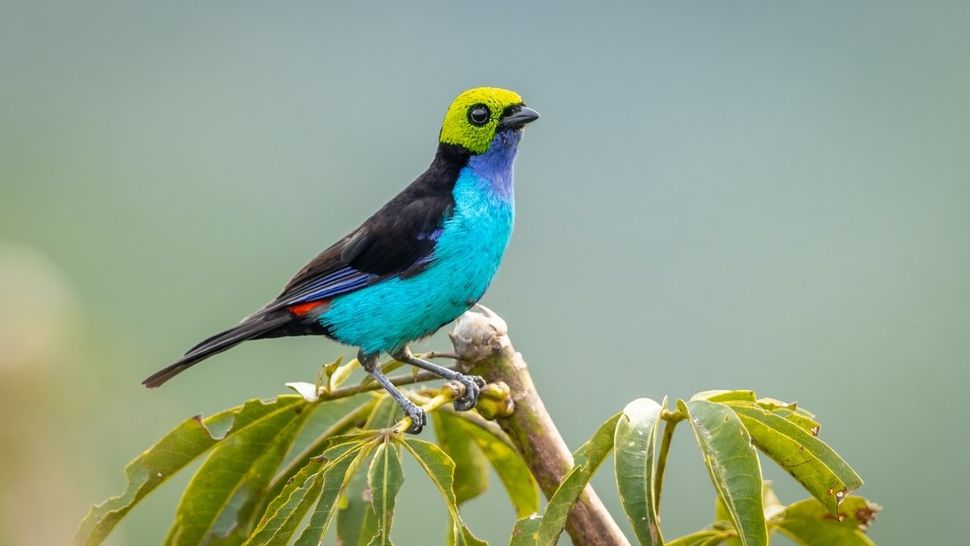
The paradise tanager (Tangara chilensis) is a captivating songbird measuring approximately 5.5 inches (14 cm) in length, adorned with a resplendent lime-green head and a mesmerizing turquoise breast and belly. Among its distinctive features, paradise tanagers exhibit variations in tail coloration, with different subspecies showcasing either red or yellow feathers at the base of their tails. Scientists have identified four subspecies of this enchanting avian species.
Endemic to the lush expanses of the Amazon rainforest and northern South America, paradise tanagers are denizens of the verdant canopy. Preferring the lofty heights, they often dwell within mixed-species flocks, darting swiftly between perches as they scour their surroundings for sustenance.
Their presence adds a vibrant touch to the rainforest tapestry, their radiant plumage and melodious calls echoing through the dense foliage. With their penchant for aerial pursuits and their affinity for the upper reaches of the canopy, paradise tanagers embody the essence of the tropical avian realm, captivating observers with their beauty and agility.
Scarlet macaw
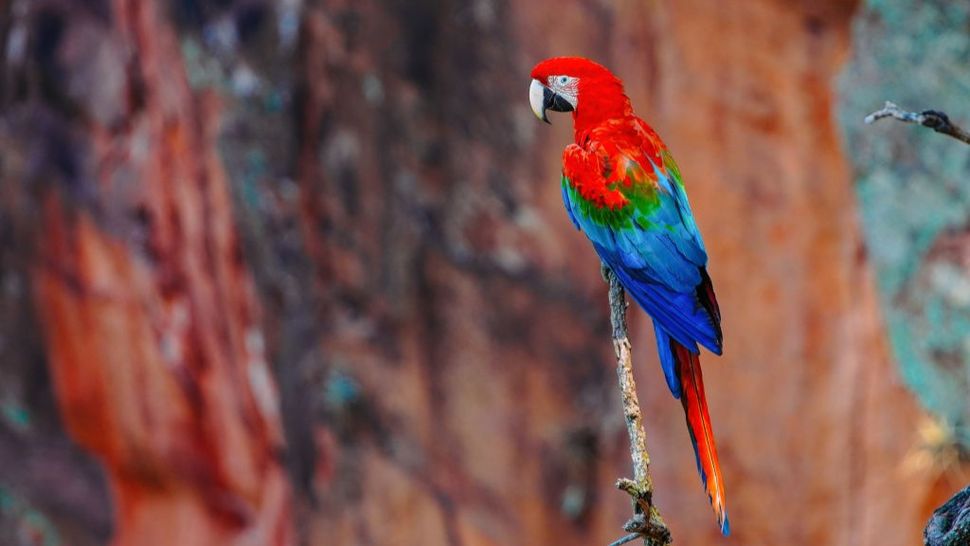
As its name implies, the scarlet macaw (Ara macao) is resplendent in vibrant red plumage, a striking sight amidst the verdant canopy of the rainforests it calls home. Complementing this fiery hue, the scarlet macaw sports azure accents on its lower back and wing tips, alongside a cheerful yellow rump and a distinctive white, featherless face.
Impressively sized, scarlet macaws hold the title of the largest parrots globally, boasting a majestic stature of up to 33 inches (84 cm) from beak to tail end. Equipped with robust beaks capable of cracking open hard nuts, these magnificent birds play a vital role in dispersing seeds throughout the expansive rainforests spanning from southern Mexico to Peru and eastern Brazil.
Scarlet macaws are known for their strong social bonds, forming lifelong pairings with their mates and congregating in large, raucous flocks. Their vibrant plumage and boisterous calls create a symphony of color and sound within their lush habitat, epitomizing the exuberance and vitality of the tropical rainforest ecosystem.
Wood duck
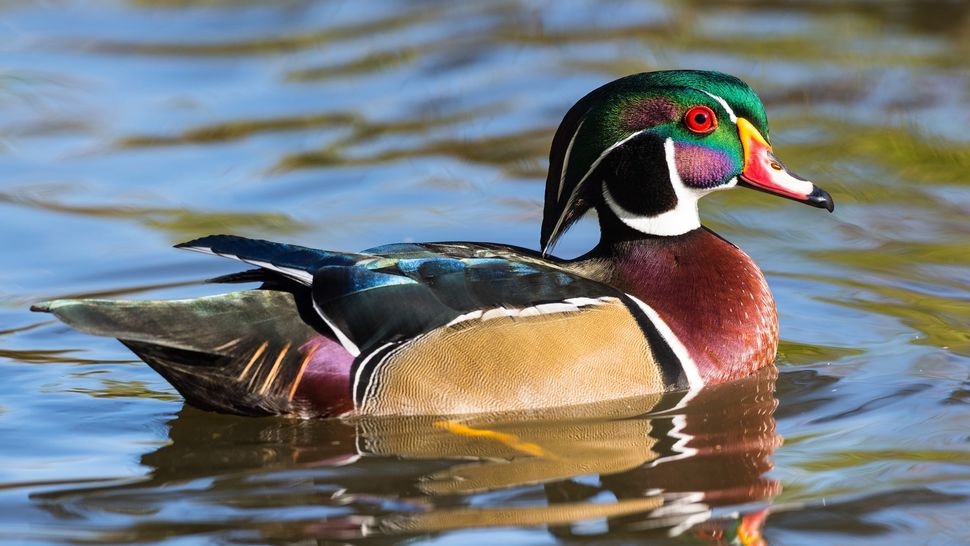
Wood ducks (Aix sponsa), commonly referred to as Carolina ducks, are indigenous to the diverse landscapes of North America. While some reside year-round in the southeastern United States and along the Pacific coast, many wood ducks inhabiting the Gulf and Atlantic coasts undertake seasonal migrations to cooler climates during the summer months.
Distinguished by their striking appearance, male wood ducks boast captivating features such as vivid red eyes and a red bill transitioning to a vibrant yellow at the base. Their crown and crest exhibit a resplendent emerald green hue, accentuated by elegant white stripes that extend to form a distinctive collar around the neck. Additional ornate details include a dark-red breast, golden-yellow sides, and exquisite blue feathers adorning their tail and wings.
In contrast, females exhibit a more subdued plumage, characterized by mottled grayish-brown tones, complemented by a subtle white ring encircling each eye—a subtle yet charming detail.
Measuring approximately 19 inches (48 cm) in length, with a wingspan spanning from 28 to 39 inches (71 to 99 cm), wood ducks embody grace and elegance in flight. Their presence adds a touch of natural beauty to the tranquil waterways and wooded habitats they inhabit, enriching the tapestry of North American wildlife with their colorful plumage and distinctive features.
Painted bunting
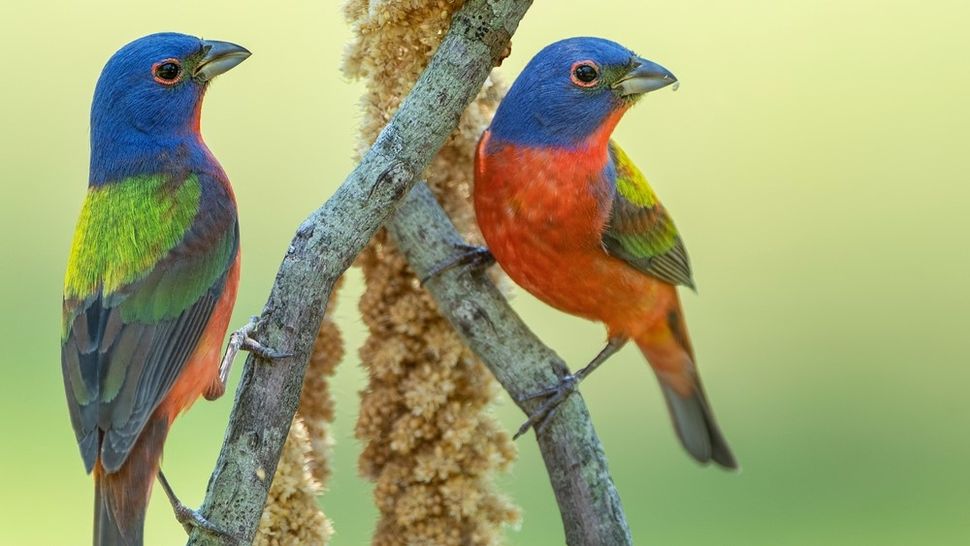
The painted bunting (Passerina ciris) is a dazzling avian gem native to the diverse landscapes of North America. With an eastern population primarily breeding in Georgia and South Carolina, and a western population centered in Texas, these vibrant birds grace their respective habitats with their radiant plumage and melodious calls.
During the breeding season, eastern individuals embark on a remarkable migration journey to wintering grounds in Florida and the Caribbean, while their western counterparts venture to the Pacific shores of Mexico. Despite their geographical separation, both populations exhibit striking similarities in appearance and vocalizations.
Adult male painted buntings are adorned with a breathtaking array of colors, featuring electric-blue feathers adorning their crown, a resplendent red breast, and a lime-green upper back. In contrast, females and young males showcase a more understated green plumage, devoid of the vibrant markings displayed by their male counterparts.
The painted bunting’s vocal repertoire adds to its allure, with a loud and shrill song resonating through the air, accompanied by sharp and metallic calls. These distinctive vocalizations contribute to the avian symphony that enlivens the woodlands and brushy habitats where painted buntings thrive, making them a cherished presence in North American birdwatching communities.
Violet sabrewing
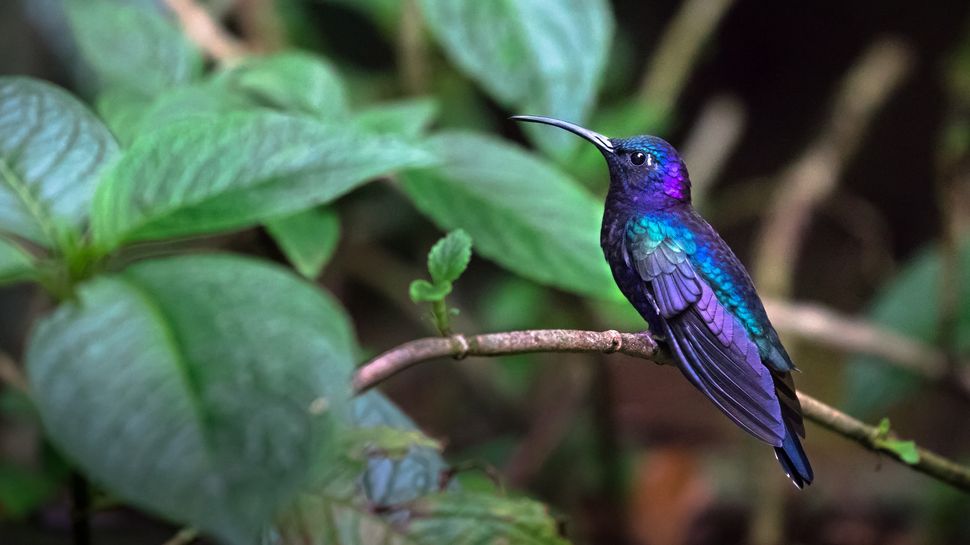
The violet sabrewing (Campylopterus hemileucurus), boasting a majestic length of up to 6 inches (15 cm), reigns as the largest species of hummingbird in Mexico and Central America. Adorned with a captivating array of iridescent plumage, males are bedecked in mesmerizing bluish-purple feathers that shimmer brilliantly in sunlight, casting an enchanting aura. In contrast, females exude a more understated elegance, adorned with subtle hints of shimmering feathers around their neck and cheeks.
Both genders of the violet sabrewing possess distinctive features, including a robust, arched bill and striking white tail corners, adding to their allure. These remarkable hummingbirds are predominantly found inhabiting the verdant realms of humid evergreen forests, where they flit gracefully among the understory foliage in search of nectar-rich blooms.
Their diet primarily consists of the sweet nectar gleaned from a variety of understory flowers, including the delicate blossoms of banana flowers and shrubs. As vital pollinators within their ecosystem, violet sabrewings play a crucial role in maintaining the ecological balance of their habitat, further underscoring their significance in the intricate tapestry of Central American and Mexican biodiversity.
Rainbow lorikeet
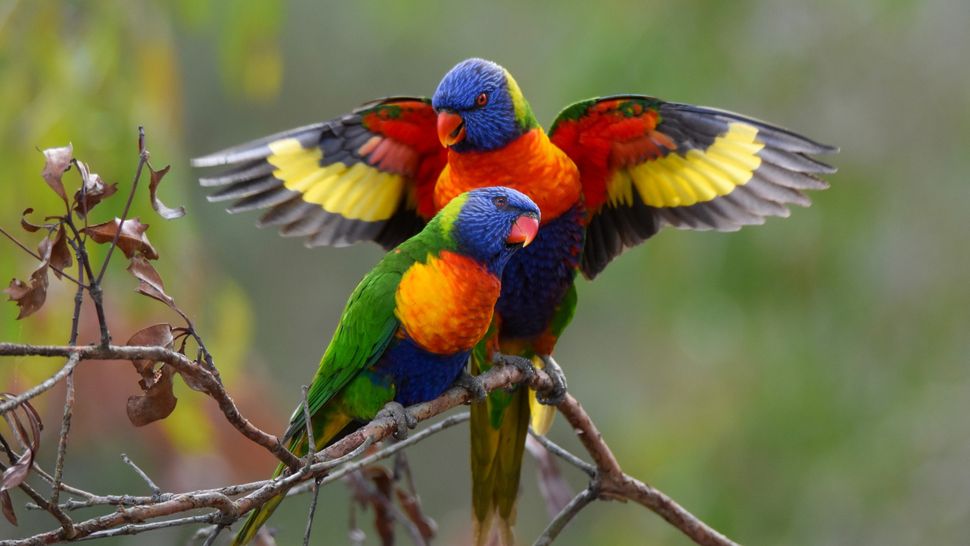
The rainbow lorikeet (Trichoglossus moluccanus) graces the skies of northern and eastern Australia with its vibrant presence. Adorned in a kaleidoscope of hues, this captivating avian boasts a crimson bill, a resplendent blue head and belly, verdant green back and wings, and a delicately dappled breast adorned in shades of yellow and orange. With their striking appearance, it’s no wonder that these birds are a beloved sight among Australian birdwatchers and enthusiasts.
Remarkably, both males and females exhibit similar plumage, showcasing the same dazzling array of colors. With an average length of approximately 12 inches (30 cm) from beak to tail, rainbow lorikeets captivate observers with their graceful flight and vibrant presence.
As a member of the “true” parrot family, rainbow lorikeets are classified within the Psittacoidea superfamily. This designation reflects their herbivorous diet and distinctive hooked bill—a characteristic trait shared among approximately 350 known species of true parrots, including iconic birds such as macaws, lorikeets, and budgerigars.
With their radiant plumage and charismatic behavior, rainbow lorikeets symbolize the beauty and diversity of Australia’s avian fauna, adding a splash of color to the natural landscapes they inhabit.
Black-backed dwarf kingfisher
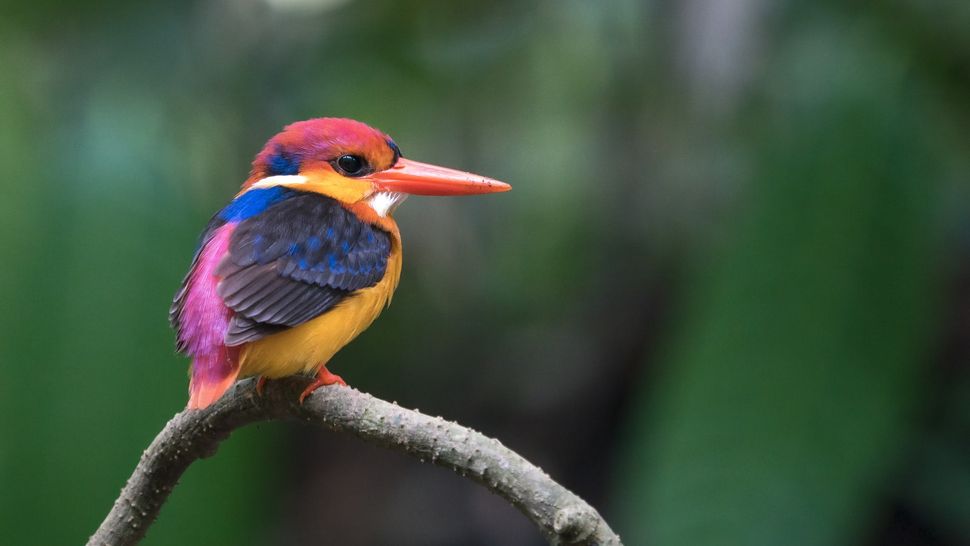
The black-backed dwarf kingfisher (Ceyx erithaca) stands out as one of the tiniest members among the kingfisher family, measuring a mere 5 to 5.5 inches (13 to 14 cm) in length, encompassing both its bill and tail. Despite its diminutive size, this avian gem captivates with its vibrant plumage and distinctive features.
Adorned with striking hues, the black-backed dwarf kingfisher showcases a crown and tail aglow in vivid fuchsia red, complemented by a coral-red bill resembling a dagger. Adding to its charm, the bird boasts a delightful palette of colors, including a pale-orange belly and cheeks, patchy wings adorned in dark-blue hues, and a pristine white throat.
Inhabiting the lush landscapes of Southeast Asia, from the verdant forests of Malaysia and Vietnam to the picturesque locales of Taiwan, Bhutan, western India, and Sri Lanka, the black-backed dwarf kingfisher displays a penchant for habitats away from traditional water sources. Its presence adds a splash of vibrancy to the diverse ecosystems it calls home, underscoring its significance as a captivating emblem of Southeast Asian avifauna.
Vulturine guineafowl
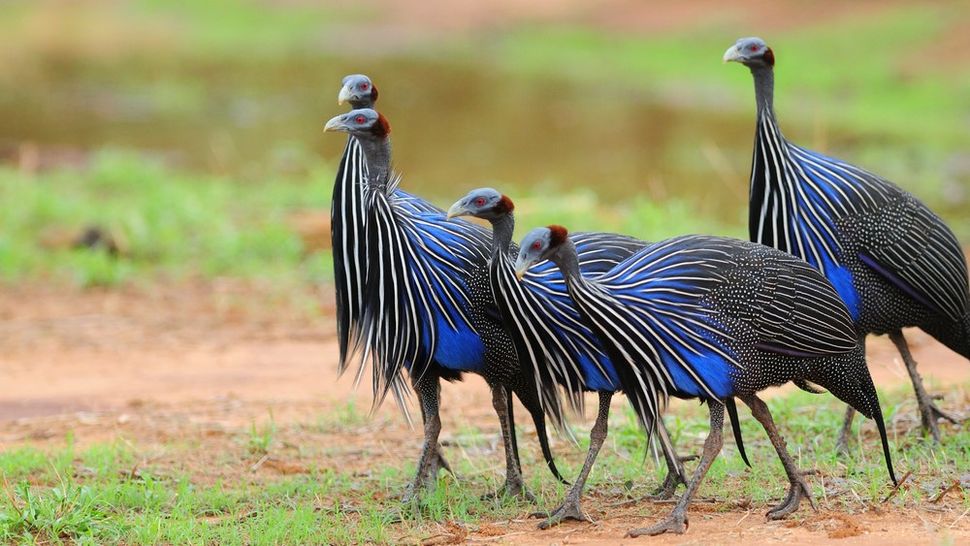
The vulturine guineafowl (Acryllium vulturinum) commands attention with its distinctive appearance and behavior. Resembling a goose in size, this long-necked bird is indigenous to the vast landscapes of eastern Africa, spanning from southern Ethiopia to northern Tanzania.
Often found traversing the dry savannas and scrublands in flocks of up to a dozen individuals, vulturine guineafowl exhibit a nomadic lifestyle as they forage for sustenance. Their diet encompasses a diverse array of seeds, tubers, roots, small reptiles, rodents, and insects, reflecting their adaptability to varied ecological niches.
Aptly named for their vulture-like appearance, these striking birds feature an electric-blue breast and back adorned with long, striking black-and-white feathers. Their distinctive red eyes, bald head, and chestnut patch on the nape further contribute to their unique aesthetic. The rest of their plumage is characterized by a captivating blend of black speckled with white, creating a visually arresting contrast.
While adults boast this mesmerizing plumage, young vulturine guineafowl exhibit a more subdued appearance, cloaked in a dull brown hue. Despite their understated attire, they grow into their vibrant plumage over time, embodying the essence of resilience and adaptation within the dynamic ecosystems they inhabit.
Curl-crested aracari
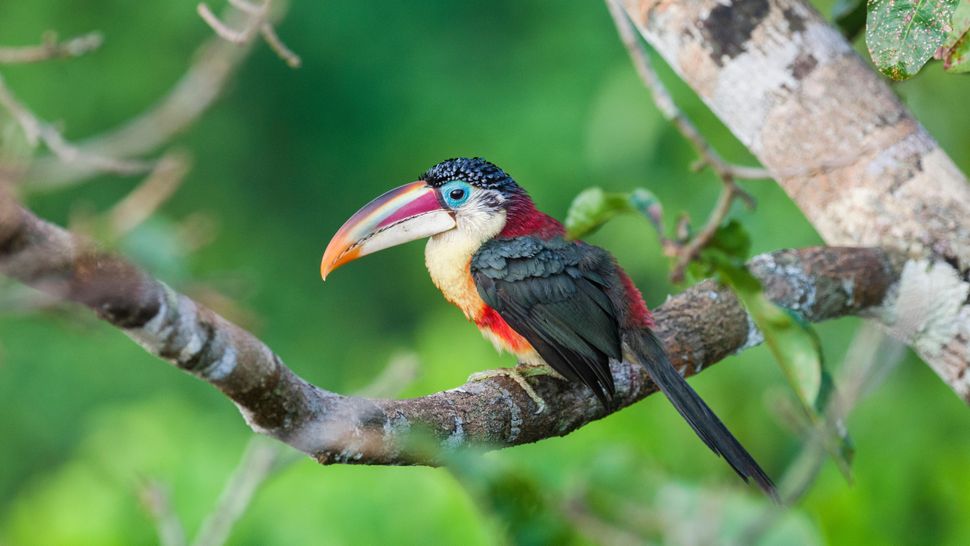
The curl-crested aracari (Pteroglossus beauharnaesii) emerges as a charming denizen of the lush, humid tropical forests spanning Bolivia, Brazil, and Peru. This diminutive toucan earns its moniker from the distinctive adornment atop its head—a crown adorned with soft, grayish curls, adding a touch of whimsy to its appearance.
Adorned with an array of vibrant hues, the curl-crested aracari boasts a turquoise circle framing its eyes, accentuating its gaze with a captivating allure. Scarlet feathers embellish its nape and belly, while its cheeks feature charming speckles, adding to its charismatic charm. However, the most striking feature undoubtedly lies in its magnificent bill—an enormous, colorful appendage that serves as both a tool for foraging and a symbol of its avian splendor.
Although not as vocal as its counterparts among the aracari family, the curl-crested aracari communicates through soft grunts and occasional loud yelps, adding to the ambiance of the forest canopy. These sociable birds traverse their verdant domain in flocks of up to a dozen individuals, engaging in the pursuit of fruit and occasionally indulging in the delicacies of other birds’ eggs and chicks.
With its enchanting presence and vibrant plumage, the curl-crested aracari epitomizes the allure of tropical avifauna, enriching the ecosystems it inhabits and captivating the hearts of bird enthusiasts with its unique charm.
Golden pheasant
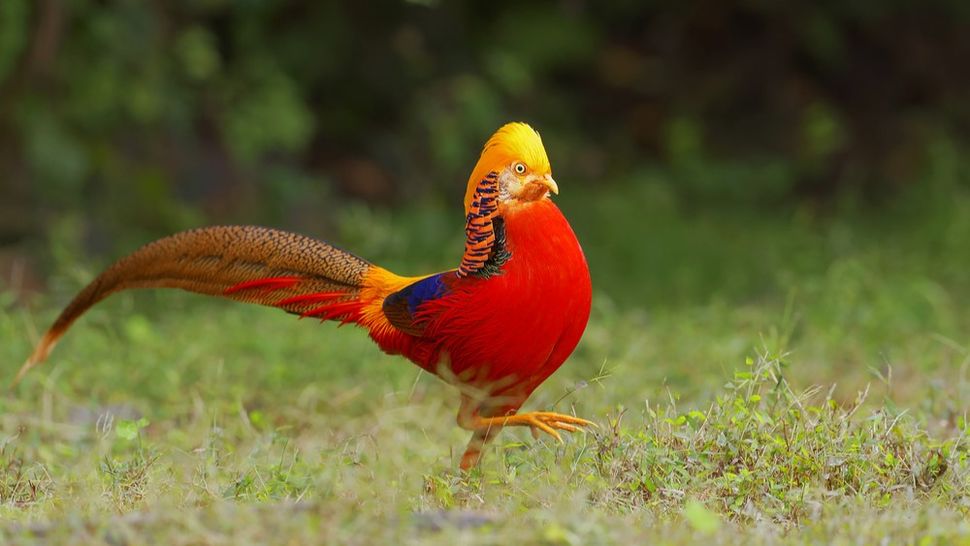
The golden pheasant (Chrysolophus pictus), often dubbed the rainbow pheasant, hails originally from the verdant landscapes of China. Introduced to the United Kingdom in the 1700s and to Hawaii in the mid-1990s, this resplendent avian gem has captivated hearts across the globe with its dazzling plumage and elusive nature.
Males of the species, stretching up to an impressive 3.8 feet (1.16 meters) from head to tail tip, boast a mesmerizing array of colors adorning their form. Their breast and underparts shimmer in bright red hues, accentuated by a golden quiff and lower back. A striped neck adorned in shades of orange and black adds to their regal appearance, while the characteristic long, finely striped tail emblematic of pheasants further enhances their allure. In contrast, females exhibit a more understated palette, with pale brown plumage finely striped throughout.
Despite their striking appearance, golden pheasants are known for their shy demeanor and elusive habits. Preferring the seclusion of dark, dense woodlands, they prove to be surprisingly challenging to spot, blending seamlessly into their natural surroundings. At nightfall, they retreat to the safety of trees for roosting, adding to the mystique surrounding these magnificent birds.
Scarlet-chested parrot
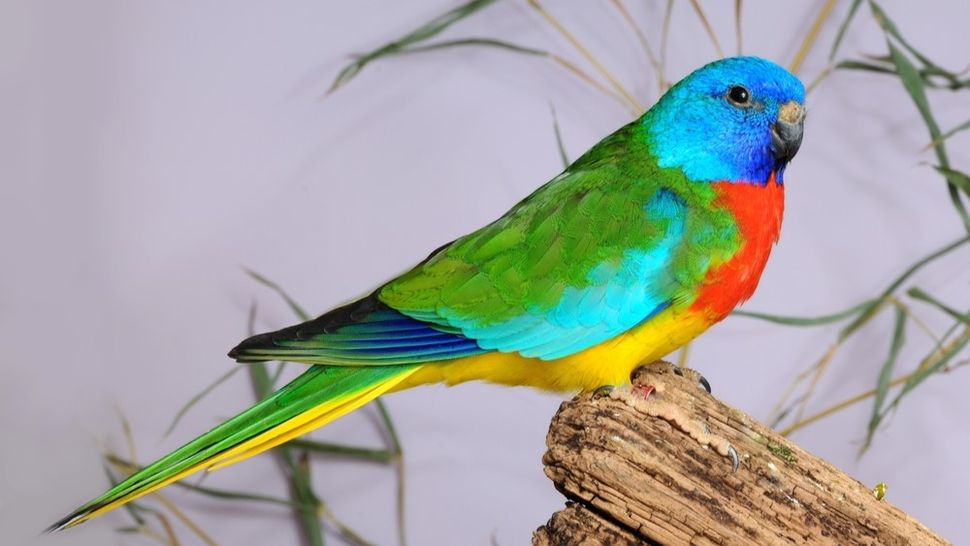
The scarlet-chested parrot (Neophema splendida) emerges as a resilient nomad, predominantly inhabiting the vast expanse of the Great Victoria Desert in southwestern Australia. Adapted to the arid conditions of its habitat, this avian wanderer possesses a remarkable ability to endure extended periods without access to drinking water, relying instead on extracting moisture from succulent plants.
Among the male scarlet-chested parrots, a vivid tapestry of colors adorns their form. Their heads and wings shimmer in bright shades of blue, while scarlet feathers embellish their breast, creating a striking contrast against the backdrop of a green back and yellow underparts. In contrast, females exhibit a slightly more subdued palette, lacking the scarlet chest adornment but retaining the inherent beauty of their plumage.
Measuring approximately 7.8 inches (20 cm) in length, these parrots emit soft, two-syllable calls reminiscent of gentle chirps when repeated, adding a melodious quality to their desert domain. However, when confronted with threats, they unleash sharp whistles, serving as a warning signal to potential adversaries.
As nomads of the desert landscape, scarlet-chested parrots embody resilience and adaptability, navigating the challenges of their environment with grace and resourcefulness, leaving a vibrant mark on the arid expanses they call home.
Roseate spoonbill
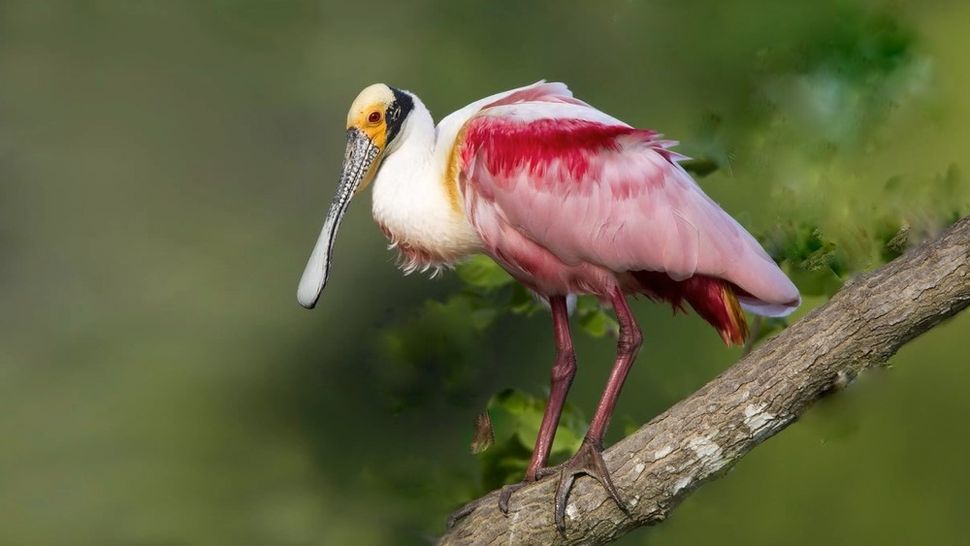
The roseate spoonbill (Platalea ajaja) emerges as a majestic figure in the realm of wading birds, adorned with a distinctive hue and unique anatomical features. Named for its captivating pink plumage and remarkable bill, which resembles a long, flattened spoon, this avian marvel commands attention with its elegant presence.
While its neck and upper back boast a pristine white hue, the roseate spoonbill’s breast, middle back, and wings are adorned in delicate shades of baby pink, casting a soft and ethereal aura. A vibrant scarlet adorns the lower back, front of the wings, and tail, punctuated by an eye-catching orange patch above the wings and encircling the eyes. As juveniles, they exude a dusty pink charm, their heads adorned with feathers that gradually give way to reveal pale-green scalps as they mature.
Spanning the landscapes from the Gulf Coast of the United States to the vast expanses of South America, these magnificent birds find sanctuary in freshwater and saltwater marshes, extending their reach as far south as the Falkland Islands in the South Atlantic Ocean. Towering up to 2.5 feet (76 cm) in height, with the largest specimens boasting an impressive wingspan of 4 feet (1.2 m), the roseate spoonbill exemplifies grace and grandeur in its natural habitat.
Nicobar pigeon
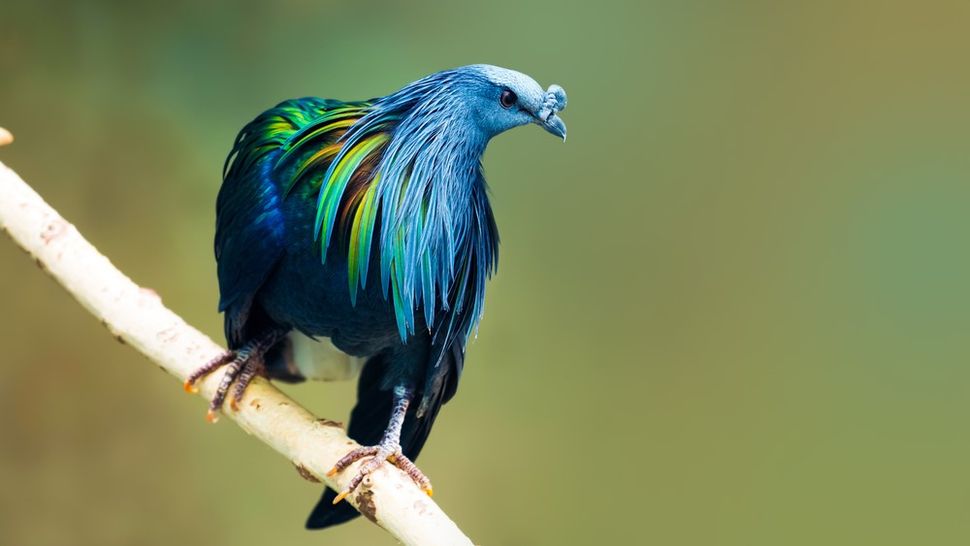
The Nicobar pigeon (Caloenas nicobarica) stands as a remarkable denizen of the earth, gracing small islands and coastal realms from the Andaman and Nicobar islands of India to the Solomon Islands in the South Pacific Ocean. As the sole surviving member of its genus, it holds a unique place in avian history, with some suggesting it may be the closest living relative of the extinct dodo.
Draped in a mane of captivating blue feathers cascading from its neck like a vibrant hula skirt, the Nicobar pigeon captivates with a tapestry of hues including green, yellow, and copper adorning its back. Slightly larger than its pigeon counterparts, it cuts a striking figure, measuring around 1.3 feet (40 cm) in length.
Despite its remarkable presence, the Nicobar pigeon faces daunting challenges in the wild. Its numbers are dwindling, threatened by the perils of capture for the pet trade and hunting for both sustenance and the coveted gizzard stones used in jewelry making. Additionally, habitat loss and the encroachment of invasive species further imperil the survival of these majestic birds, underscoring the urgent need for conservation efforts to safeguard their future in the wild.
European bee-eater
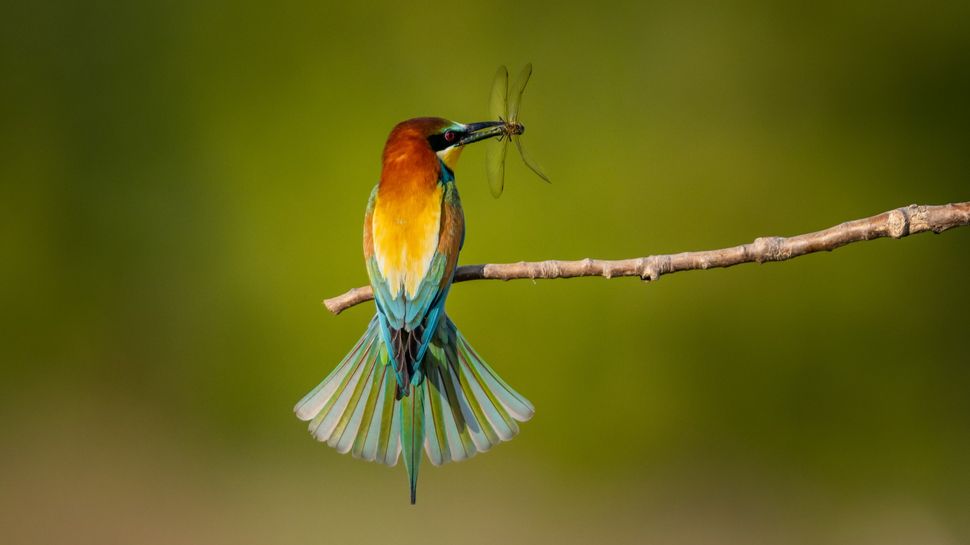
The European bee-eater (Merops apiaster) stands as one among the illustrious family of 27 known bee-eater species, a diverse clan that includes the captivating red-bearded bee-eater. Despite its moniker suggesting a more localized habitat, the European bee-eater boasts a far-reaching range that spans across eastern and southern Africa, Europe, and Mongolia.
Equipped with a slender, elongated bill, the European bee-eater masters the art of aerial insect hunting. Swift and agile, it snatches prey mid-flight, skillfully maneuvering to secure its meal. Once caught, the bee-eater employs a unique technique, deftly striking the insect against a branch to incapacitate it, ensuring a safe and venom-free feast.
Resplendent in its appearance, the European bee-eater dazzles with its vibrant plumage, featuring a sunny canary-yellow throat, a sapphire-blue belly and tail adorned with azure tips, and a regal copper crown that transitions into a tapestry of mustard-yellow feathers gracing its back.
These sociable birds embrace communal living, nesting together in burrows meticulously excavated from vertical sandbanks, fostering a sense of camaraderie within their colonies as they navigate their shared habitat with grace and elegance.
Crimson sunbird
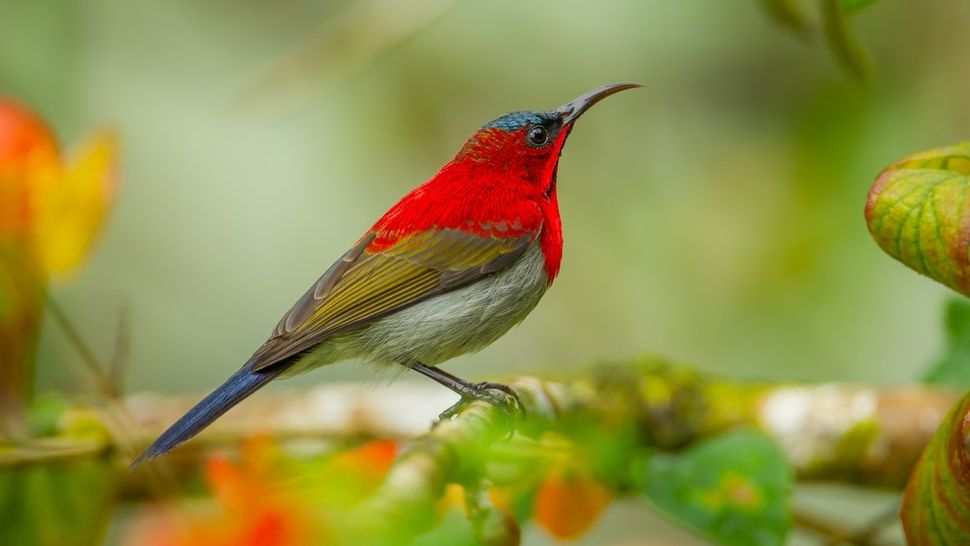
True to its name, the crimson sunbird (Aethopyga siparaja) boasts a radiant coat of vibrant red feathers, draping like a regal poncho over its breast and back. Male specimens further accentuate their allure with an iridescent-blue crown, complemented by dark, mustache-like markings adorning their neck. In contrast, females adopt a more subdued olive-yellow hue, lacking the flamboyant adornments of their male counterparts.
Measuring up to 5.3 inches (13.5 cm) in length, crimson sunbirds are a common sight across the verdant landscapes of Southeast Asia, their presence extending from the lush forests of northern India to the sun-kissed shores of Malaysia and Indonesia. Displaying remarkable agility, they possess the ability to hover in mid-air akin to hummingbirds, gracefully flitting from bloom to bloom as they sip on the sweet nectar concealed within.
While their aerial prowess is akin to that of hummingbirds, crimson sunbirds often opt for a more leisurely approach, perching delicately as they embark on their quest for sustenance. With their delicate yet vibrant presence, these sunbirds add a splash of color to the tropical tapestry they call home, enchanting all who behold their radiant beauty.
Violet-backed starling
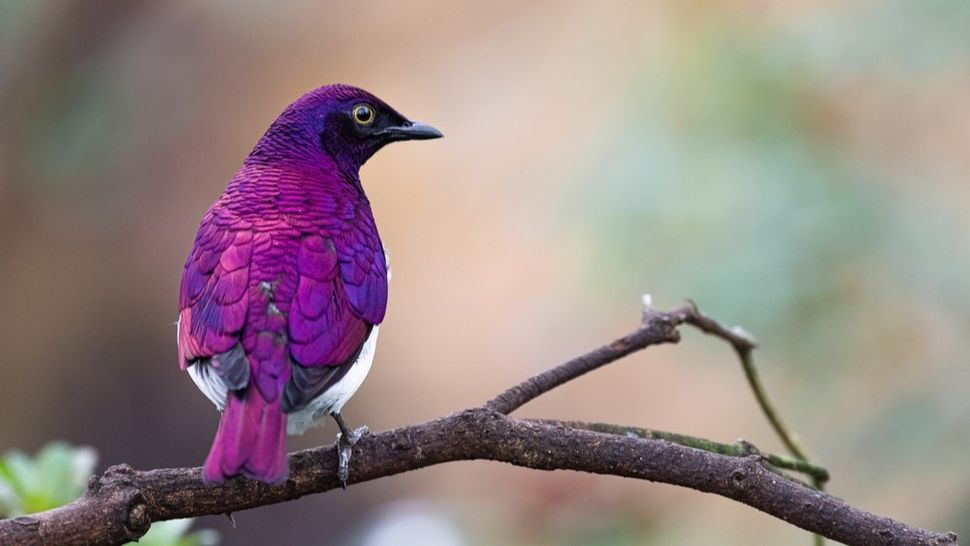
The violet-backed starling (Cinnyricinclus leucogaster), also referred to as the plum-colored or amethyst starling, stands out as a species characterized by profound sexual dimorphism, where the appearance of male and female birds diverges dramatically. Males exhibit a striking upper half adorned with iridescent-purple plumage, its hue shifting subtly with the changing light. Contrasting with this vivid display, their breast and underparts gleam with a snowy white brilliance.
In contrast, females present a markedly different visage. Their underparts mirror the pristine white of males, yet their back and head adopt a warm brown hue, intricately streaked with dark brown patterning throughout their entire body. Despite this dichotomy in appearance, both sexes contribute to the vibrancy of their habitat.
Residing in forests spanning eastern, southern, and western Africa, violet-backed starlings reach a length of approximately 6.7 inches (17 cm). Their diet is diverse, encompassing both fruit and insects, and they play a pivotal role in the ecological balance of their surroundings by aiding in the dispersal of mistletoe seeds.
With their captivating appearance and ecological significance, violet-backed starlings serve as emblematic denizens of the African wilderness, enchanting observers with their captivating presence and contributing to the rich tapestry of life within their forest homes.
Golden-hooded tanager
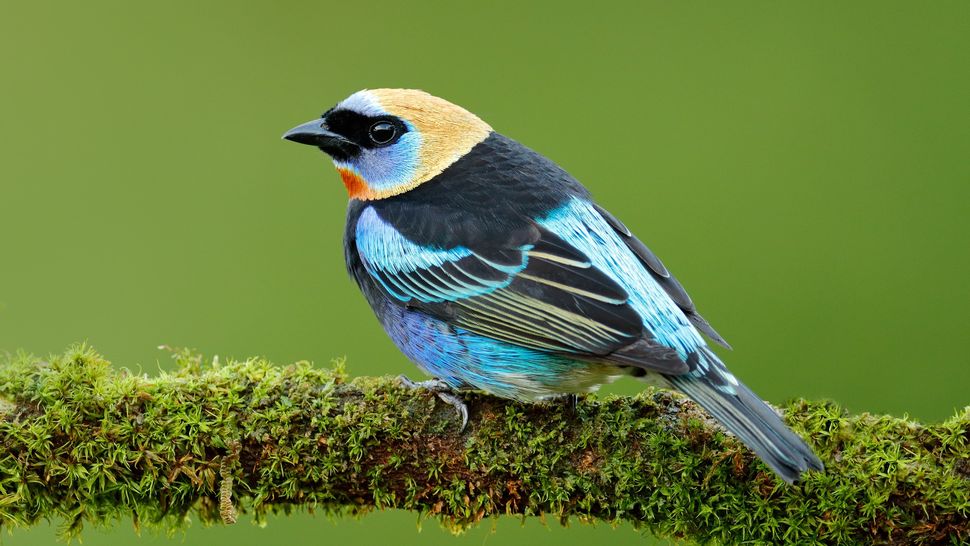
Male and female golden-hooded tanagers (Tangara larvata) share a remarkable resemblance, unlike the distinct dimorphism observed in violet-backed starlings. Both genders feature light-blue feathers that starkly contrast against predominantly black plumage, complemented by a dark-yellow hood framing the face. In contrast, the violet-backed starling exhibits an orange patch on its throat and white underparts, distinguishing it from the golden-hooded tanagers.
These tanagers inhabit a broad range spanning from southern Mexico to northwestern Ecuador, where they are occasionally spotted in feeding flocks alongside other avian species such as honeycreepers (Cyanerpes) and euphonias (Euphonia). Despite their modest size, reaching approximately 5 inches (13 cm) in length, golden-hooded tanagers display ingenuity in their nesting habits. They construct their nests snugly positioned between forked tree branches or concealed within clusters of green bananas.
In essence, the golden-hooded tanagers captivate observers not only with their striking appearance but also with their collaborative interactions within their habitat, reflecting the interconnectedness and vitality of the Neotropical avian ecosystem.
Indian roller
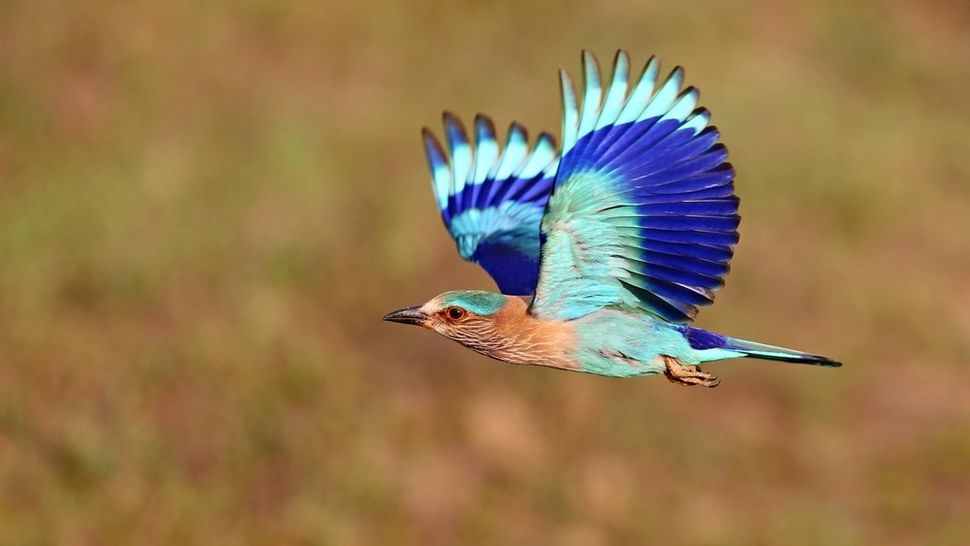
The Indian roller (Coracias benghalensis) reveals its vibrant hues most prominently during flight, showcasing wings adorned with light-blue hues accented by sapphire bands and tips. This color scheme extends to its tail feathers, which unfurl into an expansive V shape. Notably, both males and females share this striking appearance, featuring a dark-olive back, a salmon-colored breast, and distinct, protruding feathers surrounding the bill.
With a length of up to 13 inches (33 cm) and an impressive wingspan reaching 29 inches (74 cm), Indian rollers dominate the skies above open, agricultural landscapes found in regions spanning from India to the coastal areas of Oman, including territories around the Persian Gulf. These avian beauties display a preference for exposed perches, often found atop structures such as electric wires.
In essence, the Indian roller stands as a testament to the natural splendor found within these diverse ecosystems, captivating observers with its breathtaking aerial displays and vibrant plumage.
